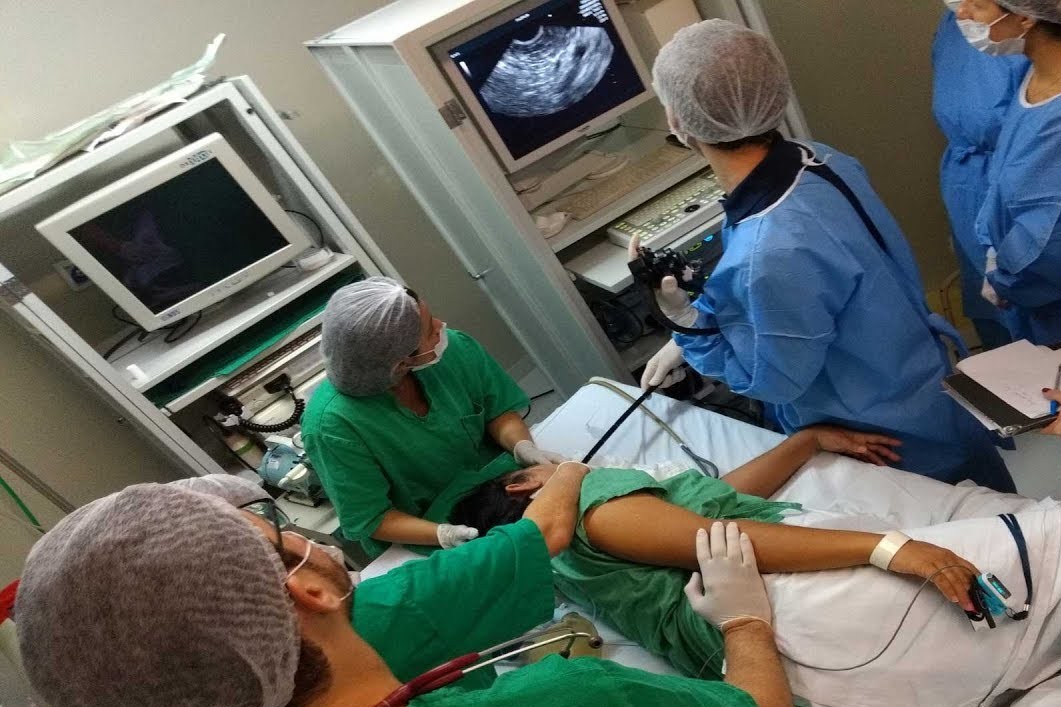
Diagnosis and treatment: what is ecoendoscopy?
Ecoendoscopy is an exploratory method of the digestive tract that combines the endoscopic image obtained with flexible probes and the ultrasound vision produced by a miniaturised ultrasound scanner placed at the tip of the instrument
Ecoendoscopy was introduced in the early 1990s to study the walls of the digestive tract or adjacent organs and anatomical structures in detail by taking an ultrasound probe inside the body.
Ecoendoscopy: what is it?
An ultrasound probe with a miniature ultrasound scanner attached to the tip is inserted into the body through the mouth or rectum.
The ultrasound scanner emits ultrasound at very high frequencies, which penetrates little into the tissues, but allows a detailed view of everything around it: the walls of the oesophagus, stomach, duodenum and rectum, as well as everything immediately beyond those walls.
Echo-endoscopy is therefore an important method for studying not only diseases of the digestive system, but also those of the thorax, biliary tract and pancreas.
For what types of pathologies is ecoendoscopy used for diagnostic purposes?
The main use of endoscopic ultrasound is the staging of malignant tumours of the digestive tract or surrounding organs.
In addition, it allows localisation and visualisation of benign lesions of the oesophageal, gastric, duodenal, intestinal or biliopancreatic wall.
Similarly, the echo-endoscope can be used to resolve diagnostic doubts about structures located near the digestive tract.
In cases where the nature of the lesions needs to be defined, small tissue samples can be taken using a thin needle ‘driven’ by the miniature ultrasound scanner.
The collected cells are then examined under a microscope to reach a precise diagnosis.
How does the needle work therapeutically?
The therapeutic applications of the method are aimed at both benign and malignant diseases of the digestive system.
The needle is passed through the wall of the digestive tract to reach adjacent anatomical structures into which drugs can be injected.
In this way it is possible to proceed with the treatment of chronic pain caused, for example, by pancreatic cancer or chronic pancreatitis: first the area responsible for pain transmission is located (celiac plexus), then the needle is penetrated and drugs are injected that block or destroy nerve transmission.
Other possible therapeutic applications of ecoendoscopy?
It is also possible to drain liquid lesions such as pseudocysts of the pancreas into the stomach. A procedure that in the past could only be performed surgically.
The possibility of decompressing sections of the digestive tract or biliary tract obstructed by inoperable tumours by means of an endoscopic procedure is also being explored.
How is the exploration performed?
Technically, it is no different from a normal endoscopic examination. However, the procedure is longer and more complex and therefore requires deeper sedation.
Preparing the patient for an endoscopic ultrasound examination
In the case of a “high” diagnostic endoscopy, the patient must be fasting. In the case of a “low” echo endoscopy, the bowel must be prepared with enemas and purges.
The procedure is quick, ranging from 10 minutes for exploration of the rectum to half an hour for the stomach or pancreas.
The latter are explored after premedication of the patient with local anaesthesia and sedation.
In the case of therapeutic echendoscopy, which is longer and more investigative, antibiotic coverage should be provided if there is a risk of infection.
After the exploration?
The patient should be kept under observation until the sedation has worn off.
When the procedure is therapeutic, monitoring should be continued to ensure that no complications occur.
Is it a risky procedure?
The most frequent discomfort, the feeling of vomiting during the examination, is minor and effectively counteracted by local anaesthesia.
In the case of needle biopsy, there is also the possibility of local complications (bleeding or infection).
But these are very rare events.
Read Also:
Bronchoscopy: Ambu Set New Standards For Single-Use Endoscope
First Time Ever: Successful Operation With A Single-Use Endoscope On Immunodepressed Child


